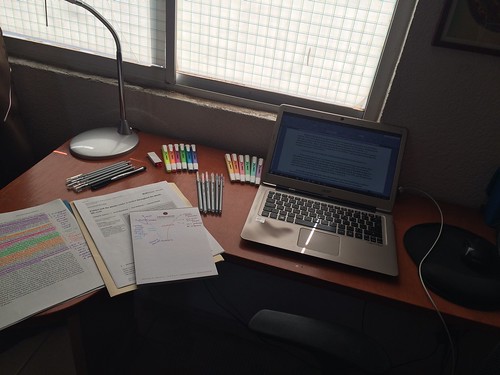I think one of the drawbacks of knowing my blog so well (as its writer!) is that I don’t reflect often enough on the various sequences of blog posts that others (particularly faculty, post-doctoral researchers and early career scholars) can use to teach my techniques. When I get hired to teach a workshop, I pick and choose from my website and produce handouts that include links to specific blog posts, so that I can then help people learn specific strategies, techniques and heuristics. But this morning, a request for help really made me think deeply about how I DO teach my students, thesis advisees and research assistants how to produce literature reviews. My approach is sequential and scaffolded, thus the title of this blog post.
My sequential strategy can be summarized as follows: I teach my students how to quickly read and absorb material using the AIC method and my template, then how to systematize their readings’ notes using the Conceptual Synthesis Excel Dump (CSED) method, and then how to build a scholarly output. I teach how to produce three levels of scholarly products (classified by degree of complexity): banks of synthetic notes, rhetorical precis and memorandums, annotated bibliographies and literature reviews, as I’ve previously outlined. The Twitter thread below outlines my approach.
1) I have 3 pieces that link the role of the Annotated Bibliography with the Literature Review
– on the value of AB’s https://t.co/6gzlmvgNiq
– on how to write an AB https://t.co/ECT6Rfevjs
– on the various types of scholarly outputs, ABs included: https://t.co/IhXJhBALzo
— Dr Raul Pacheco-Vega (@raulpacheco) June 15, 2021
If @dobsonstephen and @AliceBorchi want a piece of advice (in addition to pointing to my Literature Reviews page https://t.co/wR22xoSCE9 sorry for the immodesty), I would teach
1) why we do the LR (to situate & contextualize)
2) intermediate steps/products to a LR
3) how-to.
— Dr Raul Pacheco-Vega (@raulpacheco) June 15, 2021
The process (when I train RAs and students) then looks like this:
When I train new research assistants, I have always taught them my techniques in sequence. I teach them how to do:
1) Conceptual Synthesis Excel Dump (CSED) https://t.co/LuNbAceXTn
2) AIC content extraction https://t.co/o5Z8pl3pzF
3) Combo AIC+CSED https://t.co/KljF5Nj1dT
— Dr Raul Pacheco-Vega (@raulpacheco) June 15, 2021
Once they’ve started gaining competency in AIC+CSED (which I encourage by telling them to survey the literature and JUST focus on filling up rows of CSED – drawing from their AIC skim), I teach them how to do an Annotated Bibliography. THEN we move on to the Literature Review.
This tiered, multi-step process ensures that they understand how we scaffold different pieces of the work until we reach the point where we’ve mastered the literature (aka “conceptual saturation”)
This piece might also be helpful https://t.co/vS46jQuIvb
</end thread>
— Dr Raul Pacheco-Vega (@raulpacheco) June 15, 2021
I want to acknowledge Dr. Ali Fitzgibbon for reminding me of the importance of the double-round mind-map. It wasn’t until this morning when she articulated the idea of the double mind map in a tweet that it really cemented the process I follow and how I, too, do two mind maps of the literature (pre- and post-). And I also want to acknowledge Dr. Christina Ballico for reminding me (and others) that annotated bibliographies can be an intermediate step towards a literature review.



0 Responses
Stay in touch with the conversation, subscribe to the RSS feed for comments on this post.